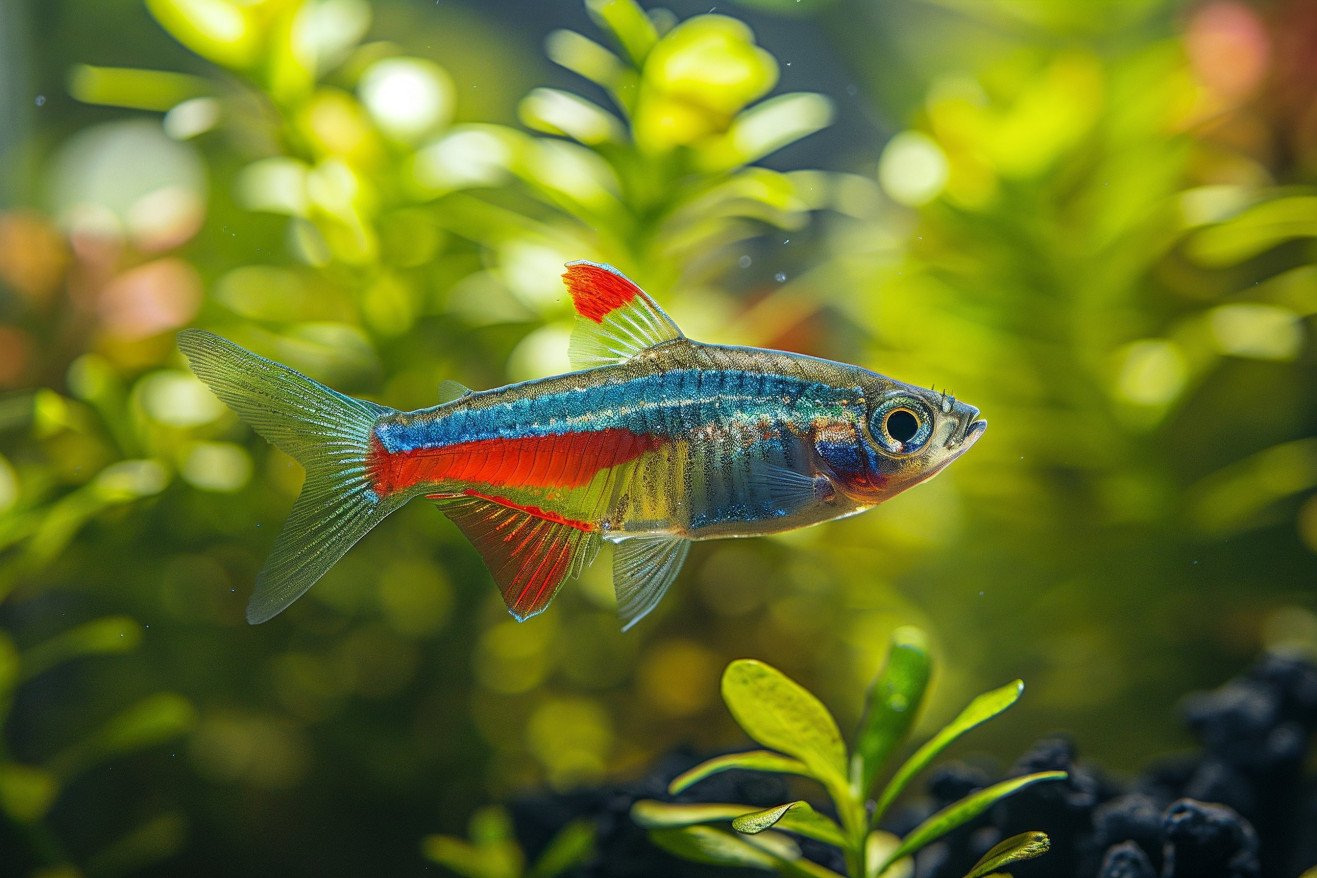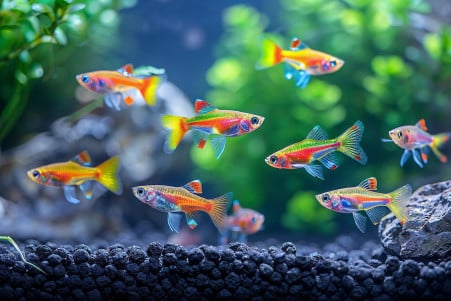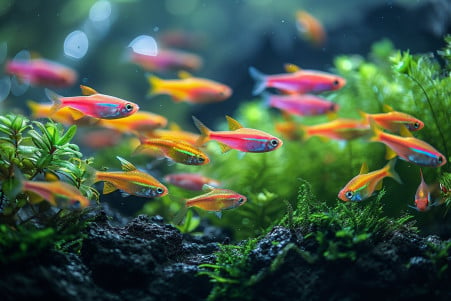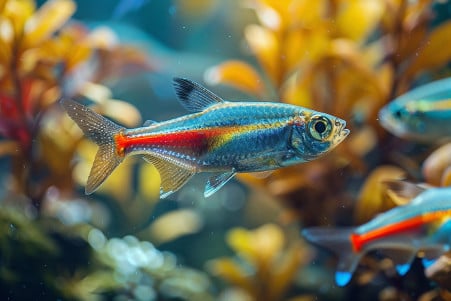The Best Neon Tetra Stocking Level for a 10-Gallon Tank: A Science-Based Answer
25 March 2024 • Updated 25 March 2024

The best number of neon tetras to stock in a 10-gallon tank depends on a variety of factors, including the size of the tank, water quality, and the schooling nature of these popular freshwater fish. Neon tetras are small, active schooling fish that should be kept in groups of 10-15 in a 10-gallon tank. If kept in smaller groups, they may become stressed and less outgoing. If kept in larger groups, the bioload may exceed the tank's capacity, leading to poor water quality. It is also recommended to have dense planting and good filtration.
To offer a more concrete answer to the question of how many neon tetras can be comfortably kept in a 10-gallon tank, we will review scientific research on neon tetra behavior, size, tank size, and tank mates. By analyzing the most up-to-date studies by ichthyologists, aquarists, and experienced fish hobbyists, we hope to provide fish keepers with the information they need to set up an environment that will support the natural behavior and beautiful colors of neon tetras.
What is the best neon tetra stocking level for a 10-gallon tank?
Neon Tetra Disease Risks and Prevention
Neon tetras are at risk for a number of common aquarium diseases that can lead to serious health problems if not treated. According to Aquarium Co-Op, some of these common diseases include ich, fin and skin flukes, and columnaris bacterial infections. If you see signs like white spots, tattered fins, inactivity, loss of appetite, and loss of color, you should act quickly.
That said, the most serious disease that can affect neon tetras is Neon Tetra Disease (NTD), which is a fatal, fast-moving parasitic disease that destroys muscle tissue. As Hepper notes, this disease is caused by Pleistophora hyphessobryconis and can be spread through live foods that have been contaminated or dead fish.
Preventing NTD and other diseases requires a multi-pronged approach. Hygger suggests quarantining new fish, keeping the water as clean as possible with regular water changes, and avoiding live foods that could bring in diseases. If you do have an outbreak, you can raise the temperature of the tank to 80-82°F, use anti-parasitic medications, and feed the fish high-quality, easily-digestible foods to help them recover.
With that said, if you keep an eye on the water quality, the food you're feeding your fish, and the way you quarantine new fish, you can help keep these beautiful, delicate fish safe from disease. That said, it's important to act quickly if you do notice any signs of NTD or other diseases since they can quickly wipe out a population of neon tetras if they're not addressed.
Stocking Recommendations and Tank Size Requirements
Neon tetras are shoaling fish and should be kept in groups of at least 6-7 in a 10-gallon tank, with 10-15 being the ideal stocking level. While a 10-gallon tank can hold up to 15 neon tetras comfortably based on the general rule of 1 inch of fish per gallon, according to Aquariadise, to allow neon tetras to school naturally, The Shrimp Farm recommends a 20-gallon tank.
Neon tetras should be added to established tanks with stable water parameters and plenty of hiding spaces, according to The Spruce Pets. Tanks should not be overstocked, as this can lead to stress, aggression, and poor water quality. As mentioned by Hepper, it's important to keep the number of neon tetras in the tank within the recommended range to ensure their health and happiness.
Best Tank Mates for Neon Tetras
Neon tetras are peaceful community fish that can be kept with other small, peaceful fish, according to PetHelpful. Some of the best tank mates for neon tetras are other small tetras, rasboras, danios, guppies, corydoras catfish, and dwarf gouramis. According to Modest Fish, bottom-dwelling fish like loaches, plecos, and otocinclus catfish can also be good tank mates.
Neon tetras can also be kept with invertebrates like cherry shrimp and nerite snails, according to Complete Koi. However, it's important to make sure that tank mates are not large, aggressive, or fin-nipping, and to avoid keeping neon tetras with incompatible fish like goldfish. Choosing the right tank mates is essential to ensuring that neon tetras can live in a healthy community tank.
Water Parameters and Tank Conditions for Neon Tetras
Neon tetras need certain water parameters and tank conditions to be happy and healthy in an aquarium. According to Aquarium Co-Op, they like soft, acidic water with a pH of 6.0-7.0. The temperature should fall between 72-82°F (22-28°C), as per Pets on Mom.com. Water hardness is best at 2-10 dGH (36-179 ppm).
To keep the water quality high, regular water changes of 25-50% are needed, per FishLore. Stress can be further reduced and natural behaviors encouraged by adding live plants, driftwood, and hiding places, says The Consolidated Fish Farms Inc..
Neon tetras are delicate when it comes to water conditions, so any changes should be made slowly to avoid shocking them. However, with regular monitoring and the right conditions, aquarium owners can make sure their neon tetras are happy and healthy in their tanks.
How to Breed and Raise Neon Tetras in Your Aquarium
While neon tetras are not the easiest fish to breed in an aquarium, it can be done if you have the right conditions and a little bit of luck. The process of breeding and raising neon tetras is outlined in detail by wikiHow, which notes that the biggest challenge is getting the fish to spawn.
To encourage spawning, you will need to set up a separate breeding tank with soft, slightly acidic water that is kept at a temperature of 77°F (25°C). You can also add oak leaves or rainwater to the tank to create a blackwater environment, which is described in a post on The Planted Tank Forum.
After the fish spawn, which is described in detail by Practical Fishkeeping, the parents should be removed from the tank to prevent them from eating the eggs or fry. The fry will need to be fed a diet of infusoria and paramecia for the first few days after they hatch, and the water in the tank will need to be changed regularly to ensure that the fry grow and develop properly.
If you can get the fish to spawn and then successfully raise the fry, you will have a new generation of neon tetras to add to your tank.
Final Insights: Optimal Stocking Level for Neon Tetras in a 10-Gallon Tank
Neon tetras are brightly colored, active schooling fish that can be kept in a well-maintained 10-gallon tank. However, it's important to make sure that the tank is properly stocked, that the fish have the right tank mates, and that the water quality is kept stable.
By following the advice of experts and the results of scientific studies, fish owners can set up a tank that will support neon tetras' health and well-being. Ongoing monitoring, water changes, and disease prevention will be important for maintaining the tank over time. With the right care and environment, neon tetras can show off their natural behaviors and beautiful colors.


